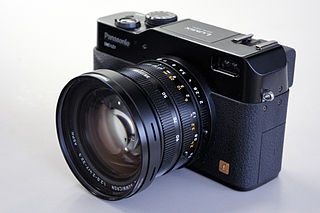
Panasonic Lumix DMC-FZ20 is a 2004 superzoom bridge digital camera by Panasonic. It is the successor of the FZ10. The highest-resolution pictures it records are 2,560 by 1,920 pixels. It has a polycrystalline, thin-film transistor, liquid crystal display and EVF. It records to Secure Digital media. The camera also has a microphone. The camera's dimensions are 127.6 mm (5.02 inches) in width, 87.2 mm (3.43 inches) in height, and 106.2 mm (4.18 inches) in depth. Its mass is 520 g.

Panasonic Lumix DMC-FZ30 is a bridge digital camera by Panasonic. It is the successor of the Panasonic Lumix DMC-FZ20. The highest-resolution pictures it records is 8 megapixels.

Lumix is Panasonic's brand of digital cameras, ranging from pocket point-and-shoot models to digital SLRs.
The Panasonic Lumix DMC-FZ7 is a six megapixel superzoom bridge digital camera that utilizes Panasonic's Venus II Engine. It features a 12× zoom lens and several modes of operation. It was replaced in 2007 by the DMC-FZ8

The Panasonic Lumix DMC-FZ8 is a 7 megapixel superzoom bridge digital camera made by Panasonic. As with most Panasonic Lumix cameras, it uses a Venus Engine, in this case, the Venus Engine III. It supports the Raw image format and has the same sensor size and zoom level as its predecessor, the Panasonic Lumix DMC-FZ7.

The Lumix DMC-L10 is Panasonic's second digital single-lens reflex camera (DSLR), a follow-up to the previous Lumix DMC-L1 model. It was announced in August 2007, and, like the Lumix DMC-L1, this model uses the Four Thirds System lens mount standard and contains some basic parts provided by Olympus.

The Panasonic Lumix DMC-TZ3 was a compact 'Travel Zoom' camera announced on January 31, 2007. It was the successor to the 2006 TZ1 announced in 2006, and was released in parallel with the TZ2. It has a 10× optical zoom with the focal range equivalent to 28–280 mm coupled with Mega O.I.S. image stabiliser. It is a fully automatic compact camera, without manual control of aperture and shutter time. The TZ3 was awarded both the TIPA "Best Superzoom Digital Camera" award and the EISA "European Compact Camera" award in 2007. The TZ4, TZ5, and TZ50 succeeded the TZ2 and TZ3.

The Micro Four Thirds system is a standard released by Olympus and Panasonic in 2008, for the design and development of mirrorless interchangeable lens digital cameras, camcorders and lenses. Camera bodies are available from Blackmagic, DJI, JVC, Kodak, Olympus, Panasonic, Sharp, and Xiaomi. MFT lenses are produced by Cosina Voigtländer, DJI, Kowa, Kodak, Mitakon, Olympus, Panasonic, Samyang, Sharp, Sigma, SLR Magic, Tamron, Tokina, TTArtisan, Veydra, Xiaomi, Laowa, Yongnuo, Zonlai, Lensbaby, Kowa, Venus Optics and 7artisans amongst others.

The Panasonic Lumix DMC-FZ18 is a superzoom bridge digital camera that features:

The Panasonic Lumix DMC-G1 was the first digital mirrorless interchangeable-lens camera (MILC) adhering to the Micro Four Thirds system design standard. The G1 camera is similar to the larger Four Thirds system format DSLR cameras, but replaces the complex optical path needed for the optical viewfinder with an electronic viewfinder EVF displaying a live view image directly from the sensor. Eliminating the mirror box and optical viewfinder allows for smaller and lighter camera bodies, while the less complex optical path also allows for smaller, lighter lens designs.
Panasonic Lumix DMC-FX37 is a digital camera by Panasonic, released late in 2008. The highest-resolution pictures it records is 10.1 megapixels, through its 25 mm ultra wide-angle Leica DC lens. It is Panasonic's first compact digital camera to support 720p video at 30 fps.

Panasonic Lumix DMC-GF1 was introduced in September 2009 as the third camera in Panasonic's Lumix G-series, using the Micro Four Thirds system. It was the first model in the "GF" line, which is primarily distinguished from the other Lumix G cameras by the lack of an integrated electronic viewfinder.

The Panasonic Lumix DMC-GH2 is a digital camera with HD video recording capability that is part of the Micro Four Thirds system. Though commonly referred to as a DSLR camera, it has no mirror or optical viewfinder, but has instead both a fold-out LCD screen and a electronic viewfinder.

The Panasonic Lumix DMC-G3 is a digital mirrorless interchangeable lens camera adhering to the joint Olympus and Panasonic Micro Four Thirds System (MFT) system design standard. The Panasonic Lumix DMC-G3 is the eighth Panasonic MFT camera introduced under the standard and the thirteenth model MFT camera introduced by either Olympus or Panasonic, as of the G3 product announcement date.

The Panasonic Lumix DMC-G2 is a digital mirrorless interchangeable lens camera adhering to the Olympus and Panasonic developed Micro Four Thirds System (MFT) system design standard. It was announced in March 2010 along with a lesser featured Panasonic Lumix DMC-G10.
The Panasonic Lumix DMC-G10 is the sixth digital mirrorless interchangeable lens camera introduced that adheres to the Micro Four Thirds System (MFT) system design standard, and the fourth Panasonic model MFT camera. The G10 model was announced concurrently with its more capable sibling, the Panasonic Lumix DMC-G2, in March 2010.

Panasonic Lumix DMC-GF3 is the eighth camera in Panasonic's Lumix G-series adhering to the Micro Four Thirds System (MFT) design standard, and was announced in June 2011.
Panasonic Lumix DMC-LZ20 is a digital camera by Panasonic Lumix from the year 2012. The highest-resolution pictures it records is 16.1 megapixels, through its 25mm Wide-Angle Lens.
Panasonic Lumix DMC-LZ30 is a digital camera by Panasonic Lumix. The highest-resolution pictures it records is 16.1 megapixels, through its 25mm Wide-Angle Lens.
Panasonic Lumix DMC-SZ1 is a digital camera by Panasonic Lumix. The highest-resolution pictures it records is 16.6 megapixels, through its 25mm Wide-Angle Leica DC VARIO-ELMAR.














